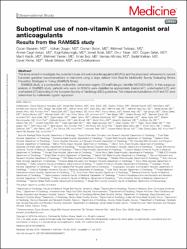Suboptimal use of non-vitamin K antagonist oral anticoagulants: Results from the RAMSES study

View/
Date
2016Author
Başaran, ÖzcanDoğan, Volkan
Beton, Osman
Tekinalp, Mehmet
Aykan, Ahmet Çağrı
Kalaycıoğlu, Ezgi
Başaran, Nesrin Filiz
Metadata
Show full item recordAbstract
This study aimed to investigate the potential misuse of novel oral anticoagulants (NOACs) and the physicians' adherence to current European guideline recommendations in real-world using a large dataset from Real-life Multicenter Survey Evaluating Stroke Prevention Strategies in Turkey (RAMSES Study).RAMSES study is a prospective, multicenter, nationwide registry (ClinicalTrials.gov identifier NCT02344901). In this subgroup analysis of RAMSES study, patients who were on NOACs were classified as appropriately treated (AT), undertreated (UT), and overtreated (OT) according to the European Society of Cardiology (ESC) guidelines. The independent predictors of UT and OT were determined by multivariate logistic regression.Of the 2086 eligible patients, 1247 (59.8%) received adequate treatment. However, off-label use was detected in 839 (40.2%) patients; 634 (30.4%) patients received UT and 205 (9.8%) received OT. Independent predictors of UT included >65 years of age, creatinine clearance 50mL/min, urban living, existing dabigatran treatment, and HAS-BLED score of <3, whereas that of OT were creatinine clearance <50mL/min, ongoing rivaroxaban treatment, and HAS-BLED score of 3.The suboptimal use of NOACs is common because of physicians' poor compliance to the guideline recommendations in patients with nonvalvular atrial fibrillation (NVAF). Older patients who were on dabigatran treatment with good renal functions and low risk of bleeding were at risk of UT, whereas patients who were on rivaroxaban treatment with renal impairment and high risk of bleeding were at risk of OT. Therefore, a greater emphasis should be given to prescribe the recommended dose for the specified patients.

















